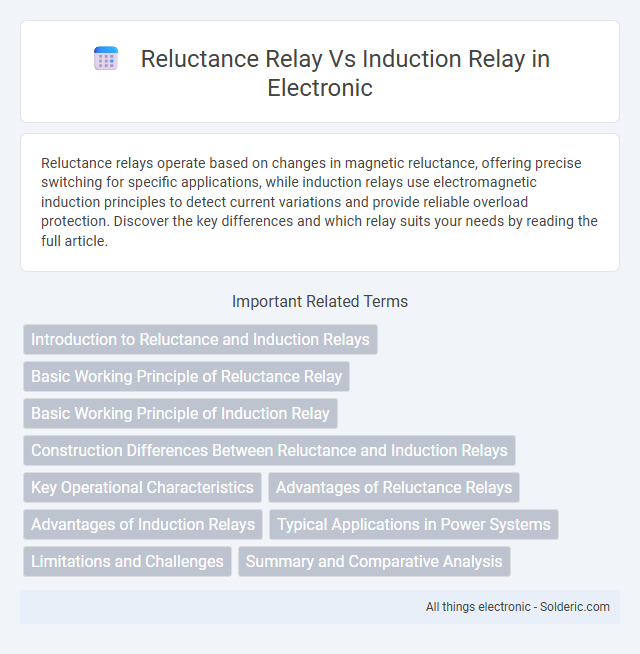Reluctance relays operate based on changes in magnetic reluctance, offering precise switching for specific applications, while induction relays use electromagnetic induction principles to detect current variations and provide reliable overload protection. Discover the key differences and which relay suits your needs by reading the full article.
Comparison Table
| Feature | Reluctance Relay | Induction Relay |
|---|---|---|
| Operating Principle | Magnetic reluctance changes alter magnetic flux to activate the relay. | Induced current in a rotating disc causes motion, triggering the relay. |
| Response Time | Faster due to direct magnetic action. | Relatively slower due to mechanical inertia. |
| Applications | Used in directional and overcurrent protection devices. | Common in overcurrent and differential protection relays. |
| Construction Complexity | Simpler magnetic circuit with fewer moving parts. | More complex with rotating discs and shading coils. |
| Maintenance | Lower maintenance due to fewer mechanical parts. | Requires regular inspection and lubrication. |
| Sensitivity | High magnetic sensitivity to flux changes. | Sensitive to current magnitude and phase angle. |
Introduction to Reluctance and Induction Relays
Reluctance relays operate based on the magnetic reluctance principle, where a change in magnetic path causes mechanical movement to trigger the relay. Induction relays function through electromagnetic induction, using induced currents to produce torque on a rotor or disc for switching. Both relays serve protective and control functions, yet differ fundamentally in their operating mechanisms and response characteristics.
Basic Working Principle of Reluctance Relay
Reluctance relays operate based on the magnetic reluctance change created by the movement of an armature in response to the magnetic field generated by current flow. When current passes through the coil, it alters the magnetic circuit's reluctance, causing the armature to move and trigger the relay contact. Your protection system benefits from the precise and reliable operation of reluctance relays in detecting current variations.
Basic Working Principle of Induction Relay
The induction relay operates on the principle of electromagnetic induction, where a rotating disc is driven by the interaction of two alternating magnetic fields produced by coils energized by the current or voltage to be measured. This rotation depends on the phase difference between these fields, allowing the relay to respond accurately to specific electrical conditions. You can distinguish it from a reluctance relay, which works based on the magnetic reluctance changes in its magnetic circuit, rather than rotating components.
Construction Differences Between Reluctance and Induction Relays
Reluctance relays have a simple construction featuring a movable ferromagnetic armature attracted by a magnetic field generated in the relay coil, while induction relays consist of a rotor and a stator, utilizing eddy currents to produce torque for operation. The reluctance relay's armature moves directly in response to magnetic force changes, whereas the induction relay's rotor rotates due to induced currents, offering smoother and more stable operation under varying frequencies. Understanding these construction differences can help you choose the appropriate relay based on application requirements like response time and reliability.
Key Operational Characteristics
Reluctance relays operate based on the magnetic attraction between a movable armature and a fixed magnetic core, providing fast response times and reliable performance in detecting current changes. Induction relays utilize electromagnetic induction principles with a rotating disc to measure current or voltage variations, offering adjustable time delays and sensitivity for protection applications. Both relays differ in their operational mechanisms, response speeds, and suitability for specific protection schemes in electrical systems.
Advantages of Reluctance Relays
Reluctance relays offer significant advantages such as faster response times and higher operating sensitivity compared to induction relays. They require less power to operate, enhancing energy efficiency and reducing overall system maintenance costs. The simple construction of reluctance relays results in greater durability and reliability, making them ideal for applications where precise and rapid switching is critical.
Advantages of Induction Relays
Induction relays offer superior durability and reliability due to their robust construction and fewer moving parts, resulting in lower maintenance requirements. Their ability to provide accurate and stable operation under varying load conditions makes them ideal for protective relay applications in power systems. Moreover, induction relays can handle high fault currents effectively, ensuring quick response times and enhancing overall system safety.
Typical Applications in Power Systems
Reluctance relays are commonly used in overcurrent protection and motor starting applications due to their fast response time and simplicity, making them ideal for protecting distribution feeders and small motors. Induction relays are preferred in distance protection and differential protection schemes because of their precise operating characteristics and ability to handle high fault currents, ensuring reliable protection of transmission lines and transformers. Both relay types play critical roles in enhancing the stability and safety of power systems by accurately detecting abnormal conditions and initiating isolation.
Limitations and Challenges
Reluctance relays face limitations such as slower response times and reduced sensitivity to low current levels compared to induction relays, which can impact their performance in fast fault detection. Induction relays, while generally more sensitive and quicker, encounter challenges like higher power consumption and mechanical wear due to continuous operation under load. Both relay types are constrained by environmental factors such as temperature variations and vibration, which can affect accuracy and reliability in protective relay applications.
Summary and Comparative Analysis
Reluctance relays operate based on magnetic reluctance changes, providing precise control in applications requiring fast response and low power consumption, while induction relays function through induced currents generating torque for reliable, heavy-duty switching. Your choice depends on the specific requirements: reluctance relays offer higher sensitivity and rapid operation, ideal for protective relaying, whereas induction relays excel in durability and handling large loads in industrial settings. Both relay types are essential for electrical protection but differ significantly in operational mechanisms and performance characteristics.
Reluctance relay vs induction relay Infographic

 solderic.com
solderic.com